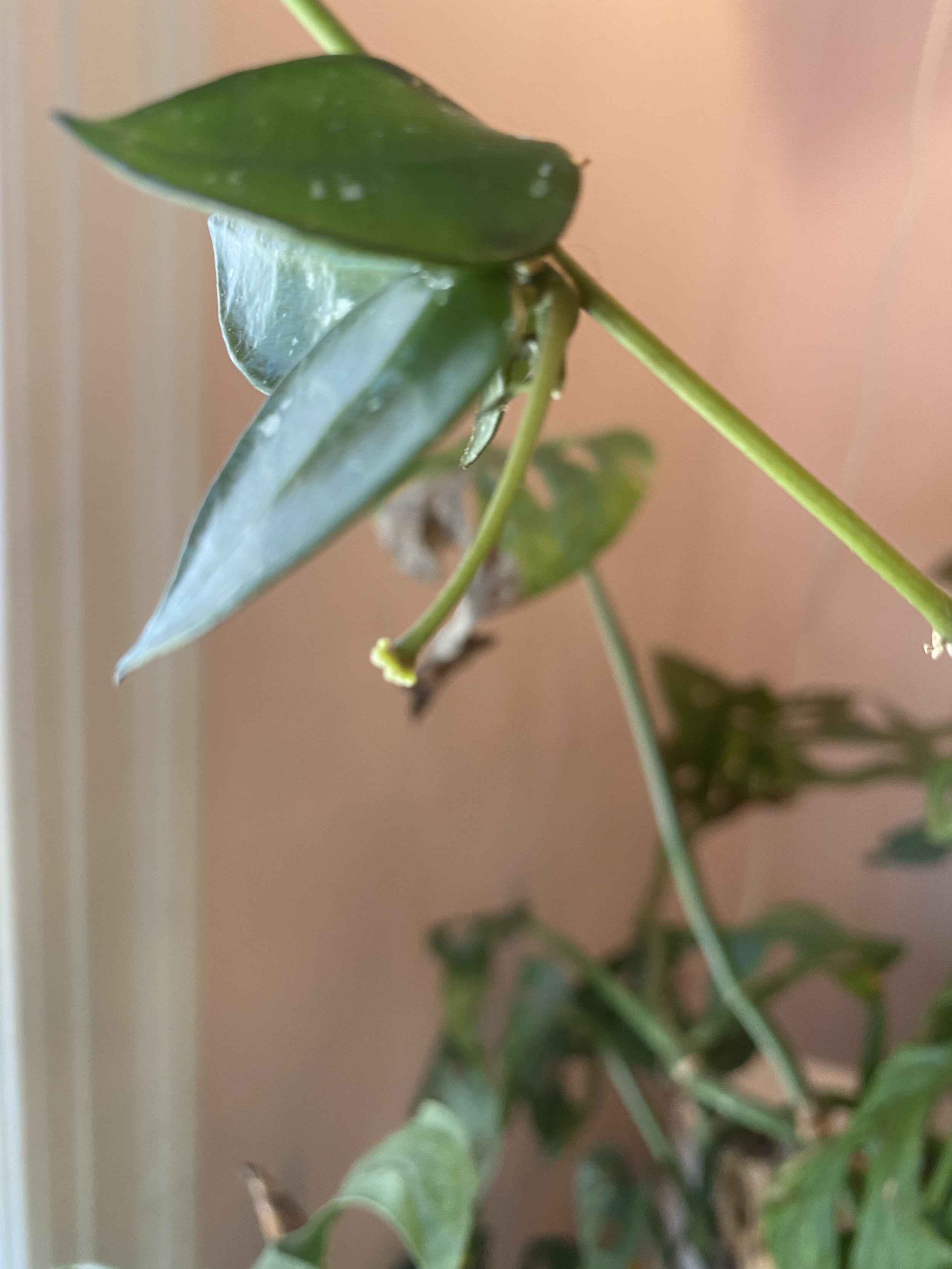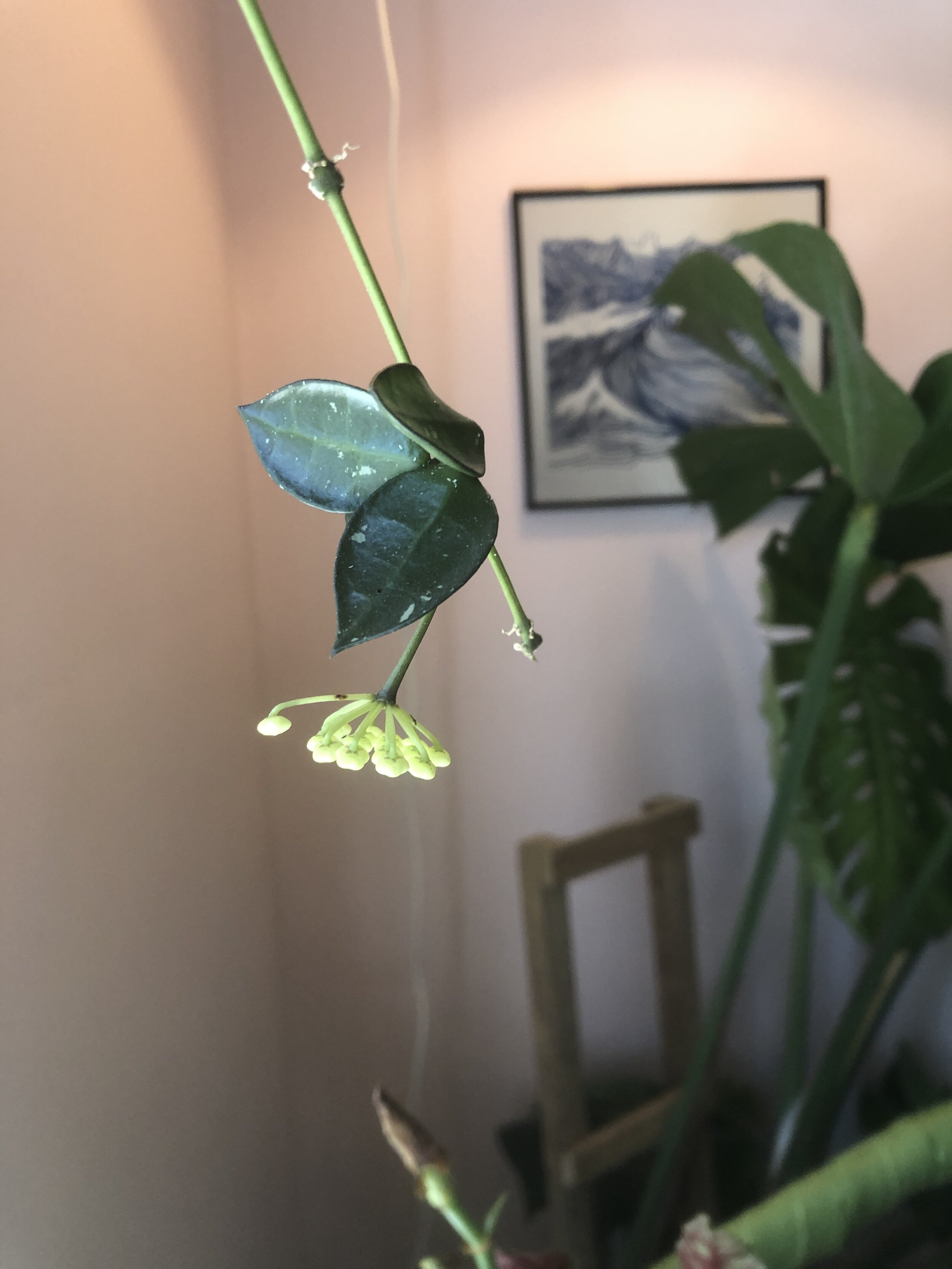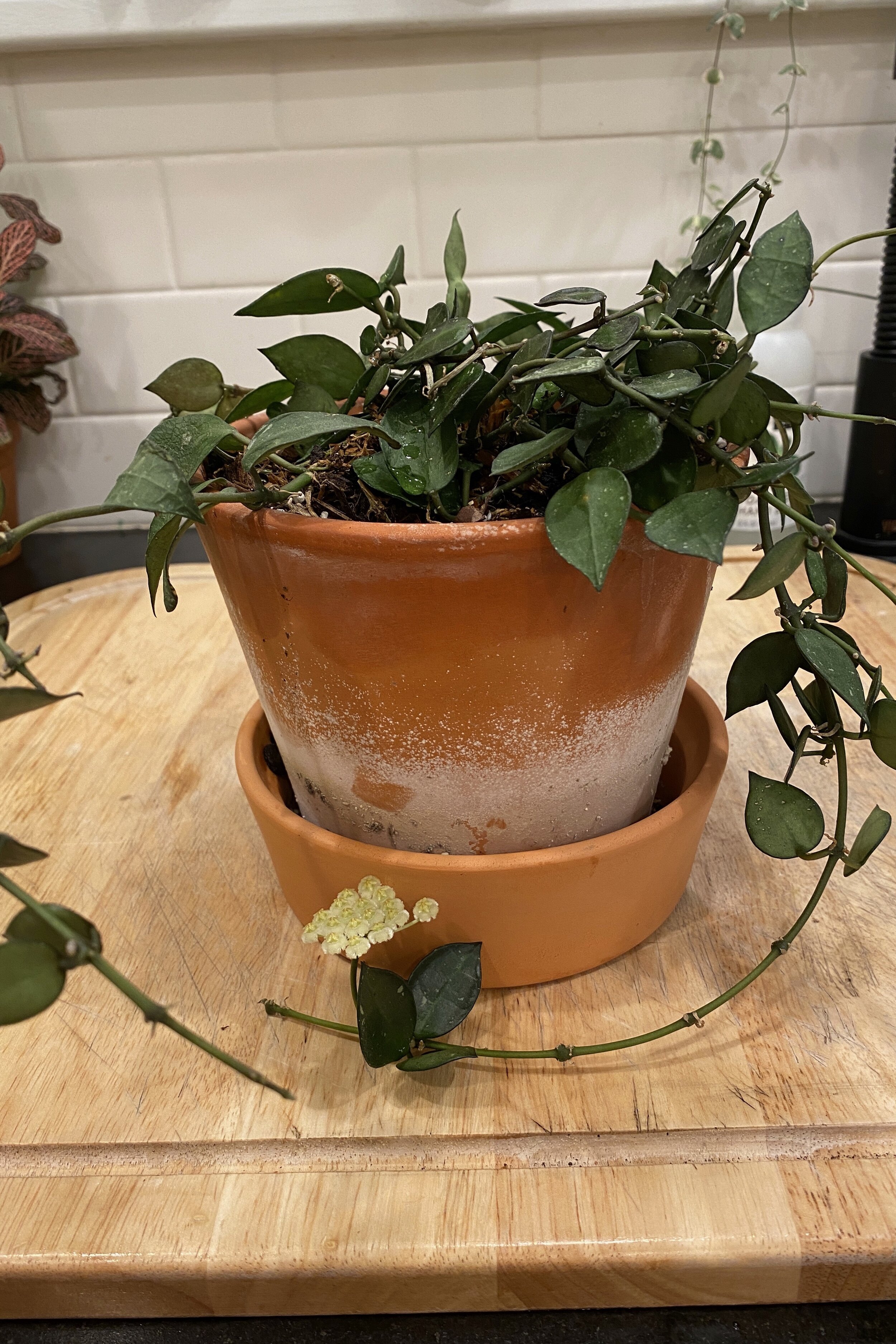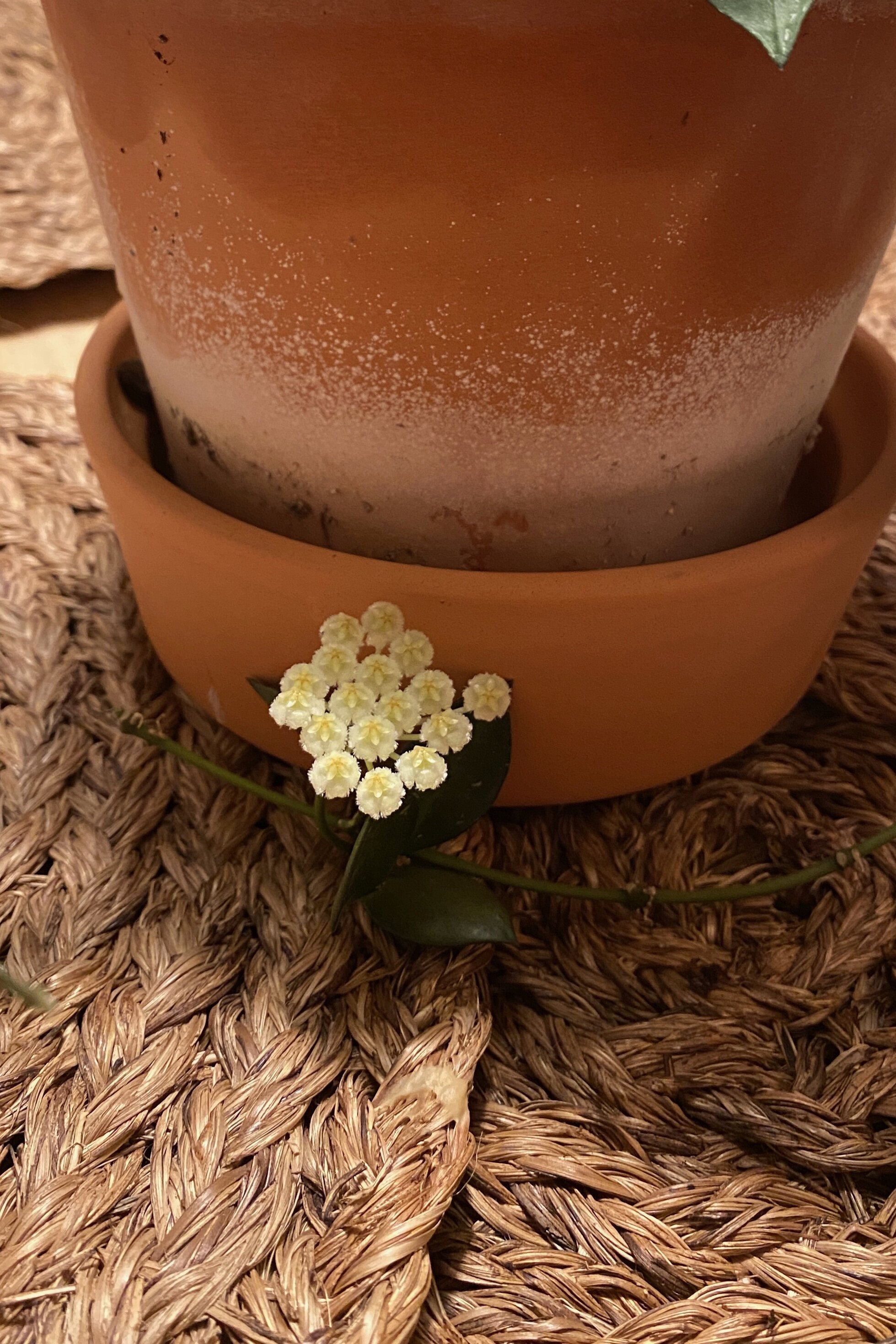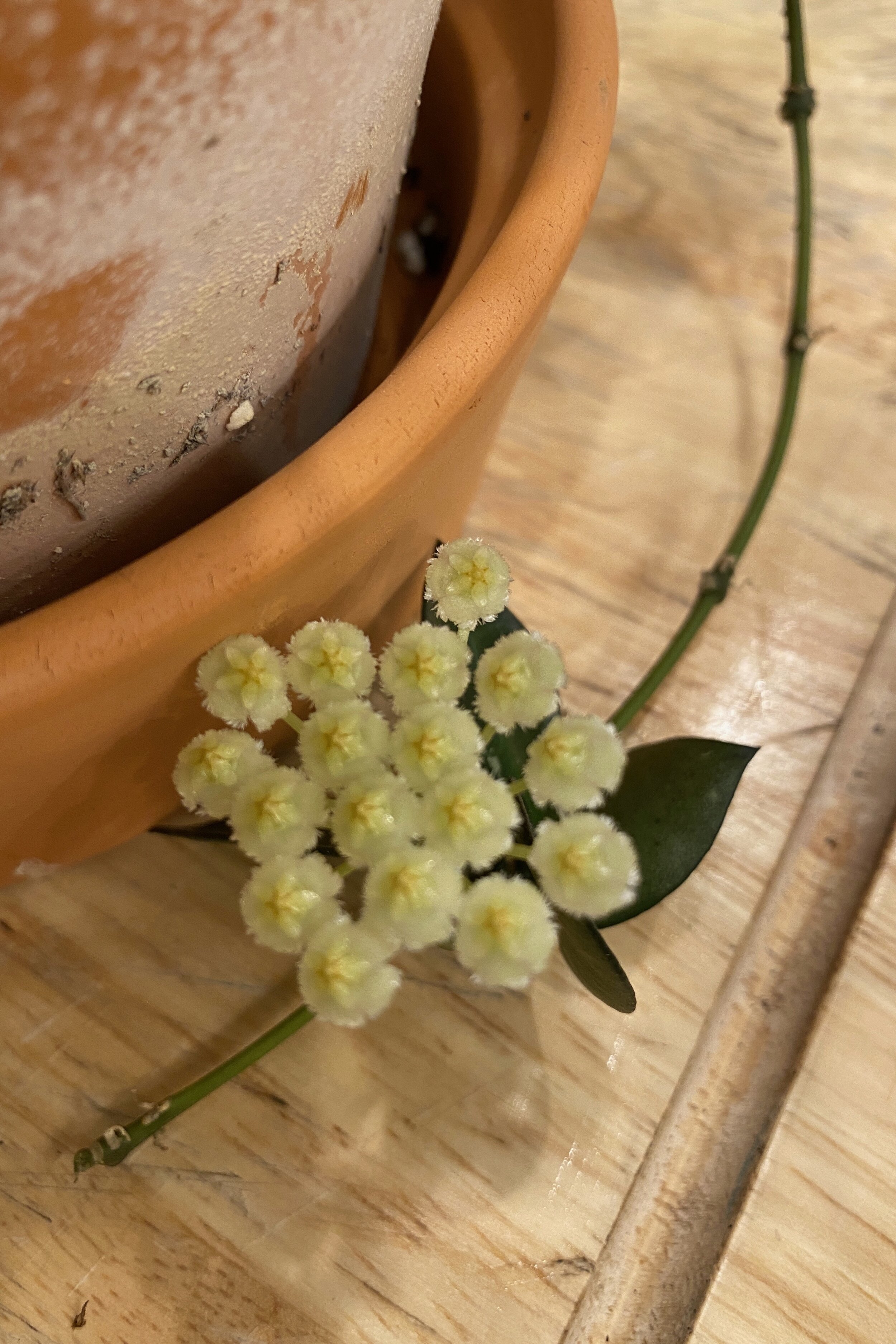In Bloom: How to Care for Hoya Krohniana.
As of July 2, 2020 Hoya krohniana is in bloom! This is her first bloom with us, and it seems like the perfect occasion to go a little deeper into Hoya krohniana.
Hoya krohniana wasn’t always, well...Hoya krohniana. She used to be known as the “Heart-Leaf Lacunosa.” Eventually, Hoya krohniana proved herself unique enough to earn her own name. My plant is just Hoya krohniana, though there are a couple of variations - Hoya krohniana “Eskimo,” which has leaves heavily patterned with whiteish silver, and Hoya krohniana “Black Leaves,” which has very dark leaves with a blackish-olive tint.
Close-up for Comparison - krohniana and lacunosa
This is an update: First up is Hoya krohniana, 8/31/21 - this is almost 14 months after my plant first bloomed.
And a closer photo of a vine to show the habit.
And here’s Hoya lacunosa below.
The full plant below, just for good measure!
I hope that helps to elucidate some of the remarkable similarities, yet significant differences in appearance for those who are visual. For those like myself who think life is better with a list, let me help you out.
Hoya krohniana earned that “Heart-Leaf lacunosa” title for a reason, the leaves look like little hearts. The foliage on Hoya lacunosa is lanceolate. Rather than having one end that’s clearly wider, both ends come to a point, with the widest section of the leaf at the middle.
Both Hoya lacunosa and Hoya krohniana could have “splashes” or dapples of lighter color on the foliage, as seen on both plants above. Both plants can be found with more “silver” in the forms Hoya lacunosa albo, and Hoya krohniana “Eskimo,” respectively.
The habit for both plants is generally trailing, though I have seen Hoya krohniana successfully trellised. The vines are of similar look and feel, though my Hoya krohniana has much more rigid vines than my Hoya lacunosa or any of my three Hoya lacunosa albo plants.
The leaves of Hoya krohniana are thick and very rigid in comparison to the almost pliable foliage of Hoya lacunosa. I do mean almost. When my Hoya lacunosa is ready for a good watering, the leaves will be soft and void of any excess water they’ve stored up for a not-so-rainy day. The day after a good watering, they’ll resist an attempt to bend them, and snap if pushed too far.
When these plants bloom, the umbels of flowers are nearly identical. Hoya krohniana is less fragrant.
The leaves of Hoya can be so telling. Not just the shape and size, but also the feel and texture. Hoya krohniana is a small-leafed Hoya. Each heart-shaped leaf is about the size of a nickel, perhaps a hair smaller. Generally, a smaller leaf indicates that a Hoya can handle more light than a plant with larger leaves. The small leaves are thick and with proper hydration, they’re firm. This means that the plant has adapted to store more water so it can withstand spells without it. If you want to get straight to the care of krohniana, skip ahead a paragraph. Otherwise, let’s talk background.
Hoya krohniana is from the Philippines, though I’ve yet to find where exactly. Lately I’ve been really into researching the native habitat of Hoya to better understand their care needs. There will be more on that in a later post. The Philippines, a cluster of over 7,000 islands, are the home to tropical rainforests. Usually, we think of the lowland rainforest as a classic example of a rainforest environment, but that’s not the only type of rainforest in the Philippines. They are also home to a subcategory within the tropical rainforest zone, a Montane or “cloud forest.” There are some major differences between the two, though they can geographically be in close proximity to each other. The lowland rainforest is, as the name suggests, at a lower elevation than the high altitude Montane. It receives more light, and not quite as much moisture, though it’s still considerably rainy and humid. The Montane is higher in altitude, often the side of a mountain or volcano, and it is blanketed in dense cloud cover giving it a misty appearance. Being, essentially, within a cloud makes for a much more damp environment. Plants from this zone are more likely to require less light and more humidity. Think ferns and mosses, although there are Hoya from the Montane as well. The fluctuations in temperature are more pronounced from day to night than a lowland rainforest. The Montane in the Philippines have an “upper Montane forest,” which indicates that the elevations can range from lowland to Montane to “upper Montane.” This gives a wide range of conditions in which Epiphytes can grow. Without knowing a specific location where Hoya krohniana was discovered, it’s hard to know where it fits in. The smaller leaves indicate that it doesn’t need maximum photosynthetic real estate to meet its light needs, which is more in line with the lowland rainforest. The thick, firm leaves suggest a plant that doesn’t rely on a constantly wet environment like the Montane to survive. That’s just my deductive reasoning at work, and I’ll certainly update as I continue learning.
As for my specific plant, I would have by no means considered it “mature” when the peduncle began growing in the spring/summer of 2020. This is good. For those of you who want to get some blooms and fast, Hoya krohniana is a great choice for you.
This is actually two plants that I potted together, I’ve always had success with that. What I’ve heard about this plant is true, it’s a quick and easy grower. I love that I can read the leaves to determine its need for water. Once they wrinkle or feel soft, I give it water. This plant lives in an east window where it does receive some direct morning sun. I put it next to the plant that is slowly revealing herself via blooms to be Hoya “Rebecca,” who is also small leafed. “Rebecca” does have lacunosa parentage. Though Hoya krohniana is not a true Lacunosa, the longtime affiliation with the Lacunosa family led me to believe that “Rebecca” and krohniana would like similar conditions.
Hoya krohniana Care:
Household temperature is perfect for this plant. It won’t like the temps getting too cool, although a few degrees drop overnight isn’t a problem. We keep it around 68-70 degrees, and that seems to be working perfectly.
Humidity might not be a considered a necessity to some, but it is definitely appreciated by any Hoya I’ve ever met. My east window has its own humidifier and I notice the plants’ disapproval if I forget to refill it for too long.
To break it down:
-Light is key. I can’t emphasize this enough. East and west windows, in my experience, are great for blooming Hoya. It’s fine for the plant to take a couple of hours of direct sun, especially if it’s morning sun. There is so much fuss out there about light, but all of my Hoya that are in bloom at this exact moment (five, to be exact) are in a window -either sitting on the sill or hanging from above the window. Due to trees or other homes, the degree of direct light varies.
-Water when the leaves feel soft or show signs of wrinkling. Check more than one leaf. Sometimes you get an oddball leaf that doesn’t act the same as the rest.
-Humidity really helps. You can avoid crispy vine tips, plus the whole plant looks perkier with humidity. Read about humidity here to learn or troubleshoot.
-Fertilize lightly. I admit to being a forgetful fertilizer with this plant because it’s hanging high and I have to get up on a chair to spray or water it. If I haven’t premixed my fertilizer into my water, I’m not likely to get up on a chair again to spray it with my liquid fertilizer. You can check out more about fertilizers here if you’re concerned about choosing the right one. For the record, this plant takes either the Miracle Gro Spray I’ve mentioned in the fertilizer page, or the Miracle Gro Tomato fertilizer. I shoot for once a month. I like to water without fertilizer too, it’s important to flush through the drainage hole (gently) with water to keep a nice balance between a nicely fertilized plant and fertilizer buildup or burn.
If you follow these guidelines, your Hoya krohniana will be blooming before you know it. It takes a little bit of time and dedication, but it’s worth it!
Here are the sources I’ve used for this blog:
https://rare-hoyas.com/Catalog.htm
https://en.wikipedia.org/wiki/Luzon_rain_forests
https://cloudforests.weebly.com/






